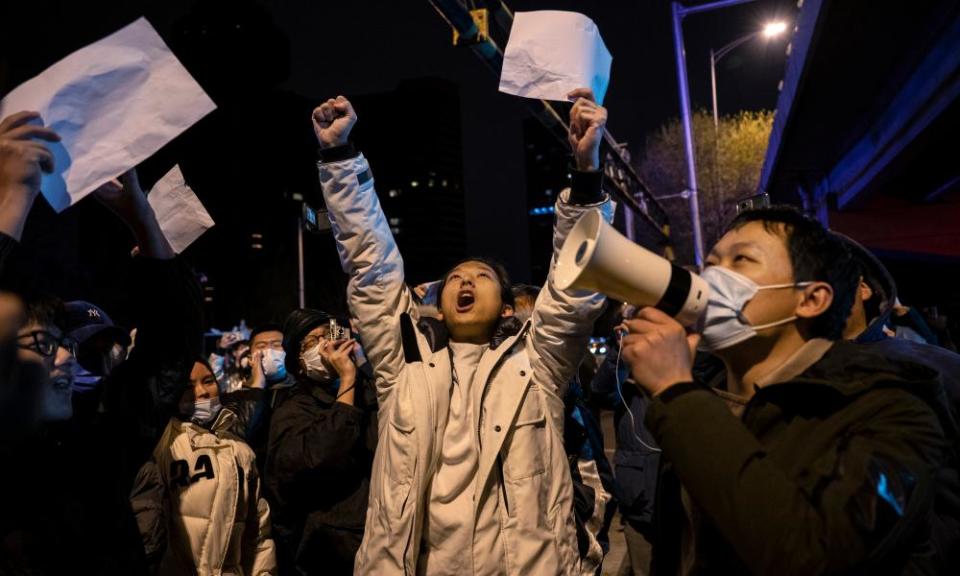Zero-Covid protests are spreading across China – but a violent crackdown will follow

China’s heavy-handed zero-Covid policy was intended to save lives. Now, it’s having devastating consequences. Last week, a fire killed at least 10 people, including children, in a tower block in Urumqi, the capital of Xinjiang. As ever in China, official numbers are unreliable, and the true number of casualties may be much higher. It’s clear that the citizens now protesting across China blame the tragedy on the lockdown, despite the claims of local officials that fire escapes in the building were not locked. Horrific videos of the fire show emergency services attempting in vain to douse the flames from beyond a roadblock, while victims scream from the windows pleading for somebody to open the doors of their apartments.
For once, the suffering of Xinjiang’s people seems to have evoked widespread empathy among China’s wider populace. When Uyghur demonstrations in Urumqi were crushed by police and security services in 2009, it evoked little sympathy from China’s ethnic Han majority. Instead, the demonstrations precipitated a wave of ethnic violence, accompanied by calls across the Chinese internet for severe punishment for the demonstrators. Similarly, the intense crackdown on Uyghur society that has been going on since 2017 – involving mass incarcerations, forced sterilisations and the destruction of communities – was largely dismissed by the rest of the Chinese populace as a necessary measure to control a defiant and restive minority.
Now, however, zealous agents of the state have rigorously enforced lockdowns across the country that have lasted months at a time. Often, as shown in innumerable videos shared online over the past three years, they have done so by chaining or barring the doors, fire escapes and gates of apartment buildings. Reports of difficulty getting medical supplies and food to families locked in their homes have been common.
Despite the extent of the restrictions across China, it was perhaps inevitable that when this tragedy came about, it would be in a Uyghur neighbourhood in Xinjiang. Lockdowns there have been particularly severe, and seem to have been targeted at minority communities. They have been widely regarded as an extension of the security lockdowns that were already a familiar feature of the region, and locals have reported that the two would sometimes blur together: people told they were being taken to centralised quarantine facilities after being alerted to a close contact with a Covid carrier have said they were instead delivered to re-education camps. The quarantine facilities themselves are no better than the camps; at the former, inmates have told of being regularly hosed down with disinfectant, and forced to swallow unknown medications.
The protests are a particularly difficult problem for the Chinese state. To see protests in Urumqi at all is shocking, given the intense security control of the region and the severe consequences of previous demonstrations. But, more than this, it is remarkable that the protests in Xinjiang comprise largely Han demonstrators. While the state has long seen minorities in Xinjiang as a problem, the region’s Han population – most of whom were moved in from inner China during the 20th century – has historically been regarded as part of the solution, tying the region more closely to the rest of the country and diluting the local Uyghur majority. This has given them comparative licence to complain, and now to protest, while many Uyghurs are understandably too terrified to leave their homes.
But the special treatment of the Han in Xinjiang is unlikely to protect them for long. The demonstrations in Urumqi are a part of a bigger movement that is troubling the streets of major cities including Shanghai and Wuhan. The state will not tolerate such dissent. Some regional protests have occasionally been successful at overturning local policies or drawing attention to corrupt officials, but zero Covid is Xi Jinping’s flagship policy in his effort to eradicate the virus from China. Any climbdown will pose a threat to his authority. The inevitable increase in cases that would follow from abandoning the policy would also undermine the state’s image as the efficient, guiding hand of the Chinese people.
There is no predicting how this will end, but the likelihood of a violent state response is high. Such a response, however, runs the risk of provoking further calls for democracy and equality that have begun to pepper the anti-lockdown protests. Just as people across China have experienced their own lockdowns and can sympathise with the Uyghur families who burned to death in their homes, they may come to further sympathise with the desire to be free of the Communist party’s iron grip.
Dr James McMurray is a research associate in anthropology and a member of the Asia Centre at the University of Sussex
Do you have an opinion on the issues raised in this article? If you would like to submit a response of up to 300 words by email to be considered for publication in our letters section, please click here.

 Yahoo News
Yahoo News 